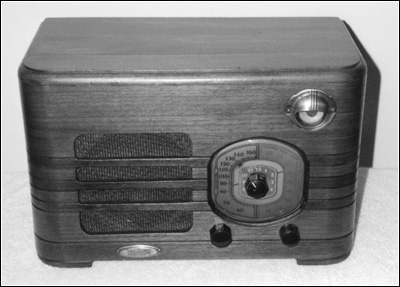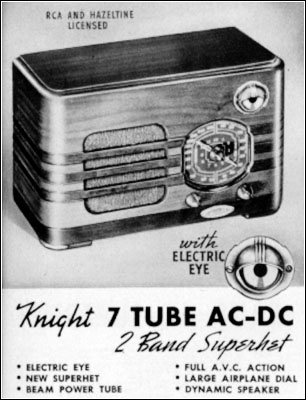Of Old Radios And Related Items--Published Monthly
A Knight 7-Tube AC/DC Radio
BY RICHARD ARNOLD
Web Edition
Ever the careful shopper for antique radios, Richard Arnold is lucky enough to have a friend in the right business an antique shop. Once again, he has found a set that inspires research in determining its history and its value. (Editor) A friend who owns an antique store in Ardmore, Oklahoma, got the Knight radio, shown in Figure 1, in a trade with a customer. He held onto it until I came by on my weekly rounds. When he showed it to me, I was a little skeptical, as the Knight brand was hardly popular, let alone a collectible one. It was, however, a nice looking example of a 1930s wooden-cased radio and it had a tuning eye. So I asked him how much he wanted. He replied that he had to get $45 for it.

Figure 1. Knight/Allied 7-tube AC/DC radio.
I looked it over carefully. It was in excellent condition, it played, and I did not have a radio with a tuning eye in my collection. Also if the tuning eye tube was good, it would be worth almost as much as the asking price for the radio. When I offered him $40, he said "OK." Now I was the owner of a mysterious Knight radio that I knew nothing about. How was I to find out more about this radio? I knew that Knight was the brand name for radios sold by Allied Radio Corp., Chicago, Illinois. Then, I remembered getting Allied Radio catalogs in the mail back in the late 1950s when I was growing up in Brookfield, Illinois. But I really never paid much attention to them. I also recalled seeing Allied Radio ads in Radio News magazines from the 1930s. While going through my March 2001 issue of Antique Radio Classified, I noticed Al Bernard's ad for out-of-print manuals that mentioned Allied Radio catalogs. I sent him a photo of my radio and asked for help in identifying my set. He responded with a photocopy from a 1938 Allied catalog that shows a radio that is similar in appearance to mine but with a different tube complement and lacking the tuning eye. Another radio shown had a tuning eye and the same tube line up as my radio, but its cabinet and speaker grille were different. However, an Allied Radio catalog for the spring and summer of 1937 brought my answer. It shows a Model A9705, which is my set. See Figure 2. The only difference is the location of the oval-shaped "Knight" nameplate.

Figure 2. The Knight 7-tune AC/DC, 2-band superhet, catalog number A9705, from the Allied Radio Corp. Spring and Summer 1937 Catalog.
The Model A9705 tunes the BC band and a short wave band (175 to 75 Meters). A 7-tube superhet, it uses the following tube types: 6A7 1st detector/oscillator, 6D6 IF, 75 2nd detector/1st AF/AVC, 25L6 AF output, 25Z5 rectifier, 6G5 tuning eye and L49C ballast. The radio uses a 5" electro-dynamic speaker. The left side of the colorful dial is green and is calibrated for the BC band. The SW scale on the right is red. The center of the dial is calibrated from 1 to 12 like a clock and seems to be purely decorative. The cabinet is finished in two-tone walnut and measures 121/2" x 8" x 71/4". The radio plays well and is quite selective even though it lacks an RF stage a good buy in 1937 at $15.25. (Richard Arnold, P.O. Box 275, Lone Grove, OK 73443) Richard Arnold, a frequent contributor to A.R.C., has been collecting radios since 1985. Primarily made up of cathedrals and 1920s battery sets, his collection also includes crystal sets and a 1928 Bosch in a Pooley cabinet. The 1932 JB Peter Pan featured in the June 1991 A.R.C. is his prize.
| [Free Sample] [Books, etc., For Sale] [Subscribe to A.R.C./Renew] [Classified Ads] [Auction Prices] [Event Calendar] [Links] [Home] [Issue Archives] [Book Reviews] [Subscription Information] [A.R.C. FAQ] URL = http://www.antiqueradio.com/Aug01_Knight_7-tube.html Copyright © 1996-2001 by John V. Terrey - For personal use only. Last revised: July 30, 2001. For Customer Assistance please contact ARC@antiqueradio.com or call (978) 371-0512 Pages designed/maintained by Wayward Fluffy Publications
Antique Radio Classified |